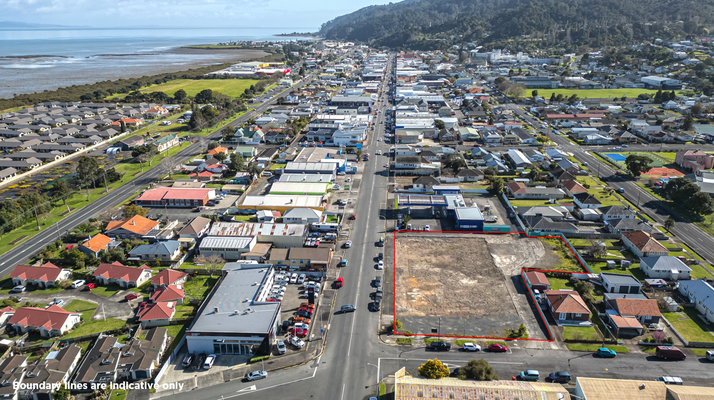-
Largest Thames CBD block in decades for sale

The biggest block of ‘brownfield’ development land seen in the central business district of Thames for two decades has been placed on the market for sale - and is set to underpin a major rejuvenation of the town’s commercial hub.
The substantial 3,567-square metre freehold site is located at 200-204 Pollen Street – Thames’ main retail route. The address previously housed a conglomeration of dated retail operations, including a superette/fruit and vegetable store, a café, and some small warehousing style structures – all of which were demolished earlier this year in preparation for a new owner to begin afresh.
Zoned for commercial use under the Thames Coromandel District Council plan, the corner site block of land has a substantial frontage directly onto Pollen Street and additionally benefits from having a second entry point off Grey Street, with considerable street parking available on both roads and quiet residential dwellings to the rear.
The adjoining L-shaped block of flat land at 200-204 Pollen Street is now being marketed for sale by tender through Bayleys Thames, with tender offers closing on Wednesday 5th November. Salesperson Josh Smith says the property consists of two titles and was the biggest bare land development opportunity to have been brought to the market for sale in central Thames for at least two decades.
‘’Sitting on the fringe of Thames’ central business district, subject to appropriate consenting approvals, the address could amply sustain a mixed-use development with retail or commercial premises at street level, vehicular parking at the rear, and a modern high-quality apartment complex on the upper levels,’’ Smith says.
‘’Apartment living in Thames has been repeatedly mooted for several years now but has yet to materialise. So any development of this nature at 200-204 Pollen Street would be a first for the town and would certainly deliver a market advantage for this type of residential living.
‘’Interestingly, an apartment living enclave is already underway at Paeroa, some 33 kilometres south-east of Thames, so there is obviously an appetite for this style of living by empty-nesters and retiring farmers moving from long-held homes and rural properties across both the Hauraki Plains and up both sides of the Coromandel Peninsula.’’
Thames sustains the Waikato’s second biggest hospital and also contains the Thames Coromandel District Council’s primary administrative headquarters.
Smith says that from an investment perspective, any new stylish and well-designed affordable apartments along Pollen Street on the CBD fringe will be highly sought after by medical staff working at the hospital, as well as permanent and contract staff working for the local authority, both just a few blocks walk away.
“Apartment living this close to the plethora of retail outlets and professional services providers along Pollen Street automatically minimises the reliance which unit owners would have on vehicular use - replicating the likes of inner-city living in Auckland or Wellington,’’ Smith says.
Thames Coromandel District Council has identified Pollen Street as being of crucial importance to the town’s ongoing prosperity – putting it near the top of the works schedule for stormwater, wastewater, and general water pipelines improvements, dovetailing with consequential roading reinstatement.
Smith says this commitment to investment in the main street has been welcomed by local stakeholders.
“From a long-term perspective, it is highly encouraging to see that the council readily acknowledges Pollen Street to be the centre of economic and social activity in Thames, and has committed funds to ensuring the road’s appeal and relevance to the wider community.”